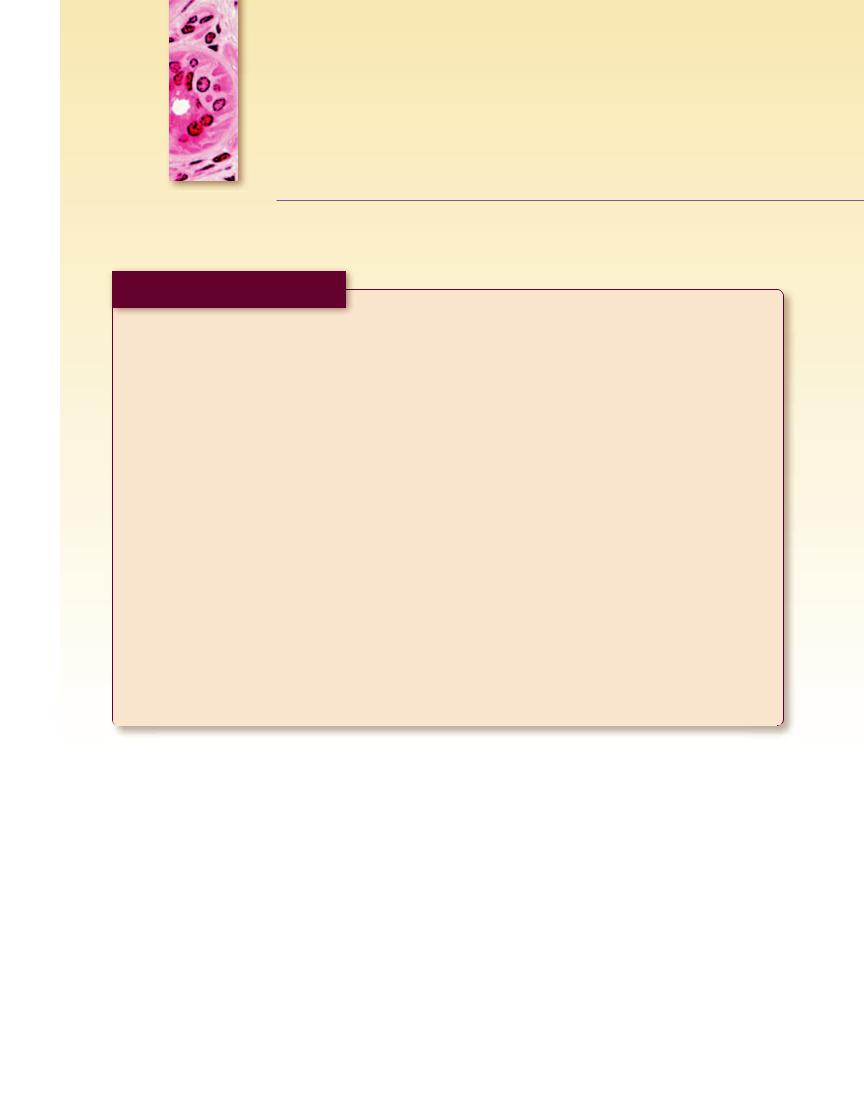
- •Preface
- •Acknowledgments
- •Reviewers
- •Contents
- •CHAPTER OUTLINE
- •CYTOPLASM
- •Plasmalemma
- •Mitochondria
- •Ribosomes
- •Endoplasmic Reticulum
- •Golgi Apparatus, cis-Golgi Network, and the trans-Golgi Network
- •Endosomes
- •Lysosomes
- •Peroxisomes
- •Proteasomes
- •Cytoskeleton
- •Inclusions
- •NUCLEUS
- •CELL CYCLE
- •CHAPTER OUTLINE
- •EPITHELIUM
- •Epithelial Membranes
- •GLANDS
- •Chapter Summary
- •CHAPTER OUTLINE
- •EXTRACELLULAR MATRIX
- •Fibers
- •Amorphous Ground Substance
- •Extracellular Fluid
- •CELLS
- •CONNECTIVE TISSUE TYPES
- •Chapter Summary
- •CHAPTER OUTLINE
- •CARTILAGE
- •BONE
- •Cells of Bone
- •Osteogenesis
- •Bone Remodeling
- •Chapter Summary
- •CHAPTER OUTLINE
- •FORMED ELEMENTS OF BLOOD
- •Lymphocytes
- •Neutrophils
- •PLASMA
- •COAGULATION
- •HEMOPOIESIS
- •Erythrocytic Series
- •Granulocytic Series
- •Chapter Summary
- •CHAPTER OUTLINE
- •SKELETAL MUSCLE
- •Sliding Filament Model of Muscle Contraction
- •CARDIAC MUSCLE
- •SMOOTH MUSCLE
- •Chapter Summary
- •CHAPTER OUTLINE
- •BLOOD-BRAIN BARRIER
- •NEURONS
- •Membrane Resting Potential
- •Action Potential
- •Myoneural Junctions
- •Neurotransmitter Substances
- •SUPPORTING CELLS
- •PERIPHERAL NERVES
- •Chapter Summary
- •CHAPTER OUTLINE
- •BLOOD VASCULAR SYSTEM
- •HEART
- •ARTERIES
- •Capillary Permeability
- •Endothelial Cell Functions
- •VEINS
- •LYMPH VASCULAR SYSTEM
- •Chapter Summary
- •CHAPTER OUTLINE
- •CELLS OF THE IMMUNE SYSTEM
- •Antigen-Presenting Cells
- •DIFFUSE LYMPHOID TISSUE
- •LYMPH NODES
- •TONSILS
- •SPLEEN
- •THYMUS
- •Chapter Summary
- •CHAPTER OUTLINE
- •PITUITARY GLAND
- •Pars Intermedia
- •Pars Nervosa and Infundibular Stalk
- •Pars Tuberalis
- •THYROID GLAND
- •Parathyroid Glands
- •Suprarenal Glands
- •Cortex
- •Medulla
- •Pineal Body
- •Chapter Summary
- •CHAPTER OUTLINE
- •SKIN
- •Epidermis of Thick Skin
- •Dermis
- •DERIVATIVES OF SKIN
- •Chapter Summary
- •CHAPTER OUTLINE
- •CONDUCTING PORTION OF THE RESPIRATORY SYSTEM
- •Extrapulmonary Region
- •Intrapulmonary Region
- •RESPIRATORY PORTION OF THE RESPIRATORY SYSTEM
- •MECHANISM OF RESPIRATION
- •Chapter Summary
- •CHAPTER OUTLINE
- •ORAL CAVITY AND ORAL MUCOSA
- •Oral Mucosa
- •Tongue
- •Teeth
- •Odontogenesis (See Graphic 13-2)
- •Chapter Summary
- •CHAPTER OUTLINE
- •REGIONS OF THE DIGESTIVE TRACT
- •Esophagus
- •Stomach
- •Small Intestine
- •Large Intestine
- •GUT-ASSOCIATED LYMPHOID TISSUE
- •DIGESTION AND ABSORPTION
- •Carbohydrates
- •Proteins
- •Lipids
- •Water and Ions
- •Chapter Summary
- •CHAPTER OUTLINE
- •MAJOR SALIVARY GLANDS
- •PANCREAS
- •LIVER
- •Exocrine Function of the Liver
- •Endocrine and Other Functions of the Liver
- •GALLBLADDER
- •Chapter Summary
- •CHAPTER OUTLINE
- •KIDNEY
- •Uriniferous Tubule
- •Nephron
- •Collecting Tubules
- •FORMATION OF URINE FROM ULTRAFILTRATE
- •EXTRARENAL EXCRETORY PASSAGES
- •Chapter Summary
- •CHAPTER OUTLINE
- •OVARY
- •Ovarian Follicles
- •Regulation of Follicle Maturation and Ovulation
- •Corpus Luteum and Corpus Albicans
- •GENITAL DUCTS
- •Oviduct
- •Uterus
- •FERTILIZATION, IMPLANTATION, AND THE PLACENTA
- •Fertilization and Implantation
- •Placenta
- •VAGINA
- •EXTERNAL GENITALIA
- •MAMMARY GLANDS
- •Chapter Summary
- •CHAPTER OUTLINE
- •TESTES
- •Spermatogenesis
- •GENITAL DUCTS
- •ACCESSORY GLANDS
- •PENIS
- •Erection and Ejaculation
- •Chapter Summary
- •CHAPTER OUTLINE
- •SENSORY ENDINGS
- •Chapter Summary
- •Terminology of Staining
- •Common Stains Used in Histology
- •Hematoxylin and Eosin
- •Wright Stain
- •Weigert Method for Elastic Fibers and Elastic van Gieson Stain
- •Silver Stain
- •Iron Hematoxylin
- •Bielschowsky Silver Stain
- •Masson Trichrome
- •Periodic Acid-Schiff Reaction (PAS)
- •Alcian Blue
- •von Kossa Stain
- •Sudan Red
- •Mucicarmine Stain
- •Safranin-O
- •Toluidine Blue

Chapter Summary
I. EPITHELIUM
A. Types
1.Simple Squamous—single layer of uniform flat cells.
2.Simple Cuboidal—single layer of uniform cuboidal cells.
3.Simple Columnar—single layer of uniform columnar cells.
4.Pseudostratified Columnar—single layer of cells of varied shapes and heights.
5.Stratified Squamous—several layers of cells whose superficial layers are flattened. These may be nonkeratinized, parakeratinized, or keratinized.
6.Stratified Cuboidal—two or more layers of cells whose superficial layers are cuboidal in shape.
7.Stratified Columnar—two or more layers of cells whose superficial layers are columnar in shape.
8.Transitional—several layers of cells, characterized by large, dome-shaped cells at the free surface, that help maintain the integrity of the epithelium during distention of the various components of the urinary tract.
B. General Characteristics
1. Free Surface Modifications
Cells may possess microvilli (brush border, striated border), short finger-like projections that increase the surface area of the cell; stereocilia (long anastomosing microvilli), which are only found in a few places in the body such as in the epididymis; and cilia, which are long, motile projections of the cell with a 9 + 2 microtubular substructure (axoneme).
2. Lateral Surface Modifications
For the purposes of adhesion, the cell membranes form junctional complexes involving the lateral plasmalemma of contiguous cells. These junctions are known as desmosomes (maculae adherentes), zonulae occludentes, and zonulae adherentes. For the purpose of intercellular communication, the lateral cell membranes form gap junctions (nexus, septate junctions).
3. Basal Surface Modifications
The basal cell membrane that lies on the basal membrane forms hemidesmosomes to assist the cell to adhere to the underlying connective tissue.
4. Basal Membrane
The basement membrane of light microscopy is composed of an epithelially derived basal lamina (which has two parts, lamina densa and lamina lucida) and a lamina reticularis derived from connective tissue, which may be absent.
II. GLANDS
A. Exocrine Glands
Exocrine glands, which deliver secretions into a system of ducts to be conveyed onto an epithelial surface, may be unicellular (goblet cells) or multicellular.
Multicellular glands may be classifi ed according to the branching of their duct system. If the ducts are not branched, the gland is simple; if they are branched, the gland is compound. Moreover, the three-dimensional shape of the secretory units may be tubular, acinar (alveolar), or a combination of the two, namely, tubuloacinar (tubuloalveolar). Additional criteria include
(1) the type of secretory product produced: serous (parotid, pancreas), mucous (palatal glands), and mixed (sublingual, submandibular), possessing serous and mucous acini and serous demilunes, and (2) the mode of secretion: merocrine (only the secretory product is released, as in the parotid gland), apocrine (the secretory product is accompanied by some of the apical cytoplasm, as perhaps in mammary glands), and holocrine (the entire cell becomes the secretory product, as in the sebaceous gland, testes, and ovary). Glands are subdivided by connective tissue septa into lobes and lobules, and the ducts that serve them are interlobar, intralobar, interlobular, and intralobular (striated, intercalated).
Myoepithelial (basket) cells are ectodermally derived myoid cells that share the basal lamina of the glandular parenchyma. These cells possess long processes that surround secretory acini and, by occasional contraction, assist in the delivery of the secretory product into the system of ducts.
B. Endocrine Glands
Endocrine glands are ductless glands that release their secretion into the bloodstream. These glands are described in Chapter 10.
56

3 CONNECTIVE TISSUE
CHAPTER OUTLINE
Graphics
Graphic 3-1 Collagen p. 66
Graphic 3-2 Connective Tissue Cells p. 67
Tables
Table 3-1 Types of Glycosaminoglycans (GAGs) Table 3-2 Mast Cells Factors and Functions
Plates
Plate 3-1 |
Embryonic and Connective Tissue |
|
Proper I p. 68 |
Fig. 1 |
Loose (areolar) connective tissue |
Fig. 2 |
Mesenchymal connective tissue |
Fig. 3 |
Mucous connective tissue. Umbilical |
|
cord. Human |
Fig. 4 |
Reticular connective tissue. Silver stain |
Plate 3-2 |
Connective Tissue Proper II p. 70 |
Fig. 1 |
Adipose tissue. Hypodermis |
Fig. 2 |
Dense irregular collagenous connective |
|
tissue. Palmar skin |
Fig. 3 |
Dense regular collagenous connective |
|
tissue. Tendon l.s. |
Fig. 4 |
Dense regular collagenous connective |
|
tissue. Tendon x.s. |
Plate 3-3 |
Connective Tissue Proper III p. 72 |
Fig. 1 |
Dense regular elastic connective tissue l.s. |
Fig. 2 |
Dense regular elastic connective tissue x.s. |
Fig. 3 |
Elastic laminae (membranes). Aorta |
Fig. 4 |
Mast cells, plasma cells, macrophages |
Plate 3-4 |
Fibroblasts and Collagen, Electron |
|
Microscopy p. 74 |
Fig. 1 |
Fibroblast (EM) |
Plate 3-5 |
Mast Cell, Electron Microscopy p. 75 |
Fig. 1 |
Mast cell (EM) |
Plate 3-6 |
Mast Cell Degranulation, Electron |
|
Microscopy p. 76 |
Fig. 1 |
Mast cell degranulation (EM) |
Plate 3-7 |
Developing Fat Cell, Electron |
|
Microscopy p. 77 |
Fig. 1 |
Developing fat cell (EM) |
58
